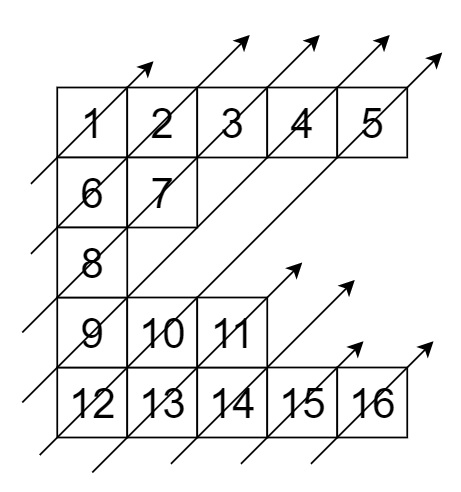
 Data Structure
Data Structure Networking
Networking RDBMS
RDBMS Operating System
Operating System Java
Java MS Excel
MS Excel iOS
iOS HTML
HTML CSS
CSS Android
Android Python
Python C Programming
C Programming C++
C++ C#
C# MongoDB
MongoDB MySQL
MySQL Javascript
Javascript PHP
PHP
- Selected Reading
- UPSC IAS Exams Notes
- Developer's Best Practices
- Questions and Answers
- Effective Resume Writing
- HR Interview Questions
- Computer Glossary
- Who is Who
Diagonal Traverse II in C++
Suppose we have a list of lists called nums, we have to show all elements of nums in diagonal order.
So, if the input is like

then the output will be [1,6,2,8,7,3,9,4,12,10,5,13,11,14,15,16]
To solve this, we will follow these steps −
Define an array ret
Define one 2D array v
-
for initialize i := 0, when i < size of nums, update (increase i by 1), do −
-
for initialize j := 0, when j < size of nums[i], update (increase j by 1), do −
insert { nums[i, j], i, j } at the end of v
-
sort the array v
-
for each it in v, do,
insert it[0] at the end of ret
return ret
Example
Let us see the following implementation to get better understanding −
#include <bits/stdc++.h>
using namespace std;
void print_vector(vector<int> v){
cout << "[";
for(int i = 0; i<v.size(); i++){
cout << v[i] << ", ";
}
cout << "]"<<endl;
}
class Solution {
public:
static bool cmp(vector <int>& a, vector <int>& b ){
int sum1 = a[1] + a[2];
int sum2 = b[1] + b[2];
return sum1 == sum2 ? a[1] > b[1] : sum1 < sum2;
}
vector<int> findDiagonalOrder(vector& nums) {
vector<int> ret;
vector<vector<int> > v;
for (int i = 0; i < nums.size(); i++) {
for (int j = 0; j < nums[i].size(); j++) {
v.push_back({ nums[i][j], i, j });
}
}
sort(v.begin(), v.end(), cmp);
for (auto& it : v)
ret.push_back(it[0]);
return ret;
}
};
main(){
Solution ob;
vector<vector<int>> v = {{1,2,3,4,5},{6,7},{8},{9,10,11},{12,13,14,15,16}};
print_vector(ob.findDiagonalOrder(v));
}
Input
{{1,2,3,4,5},{6,7},{8},{9,10,11},{12,13,14,15,16}}
Output
[1, 6, 2, 8, 7, 3, 9, 4, 12, 10, 5, 13, 11, 14, 15, 16, ]

Advertisements
